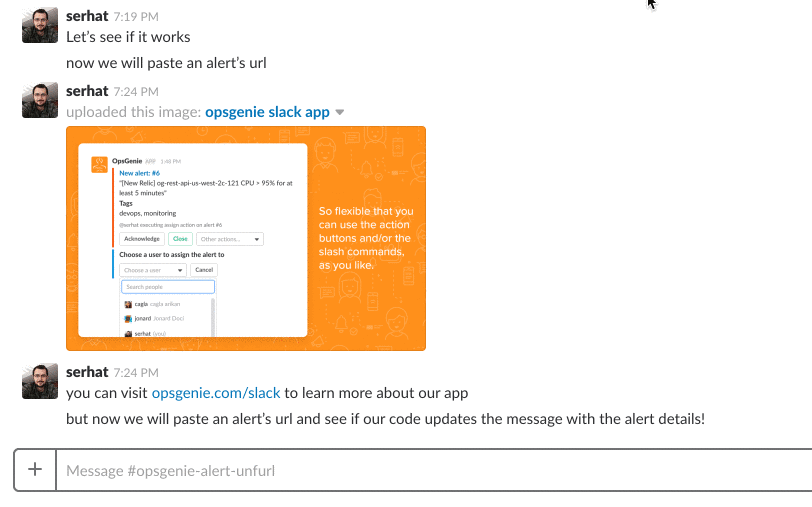Opsgenie Slack
The combination of OpsGenie and Statuspage with Jira Service Desk is a recipe for your team's success.
- Opsgenie Slack Incident
- Opsgenie Create Slack Channel
- Opsgenie Slack Integration
- Opsgenie Slack
- Opsgenie Slack Oncall
Alertmanager is configured viacommand-line flags and a configuration file.While the command-line flags configure immutable system parameters, theconfiguration file defines inhibition rules, notification routing andnotification receivers.
The visual editorcan assist in building routing trees.
To view all available command-line flags, run alertmanager -h.
Alertmanager can reload its configuration at runtime. If the new configurationis not well-formed, the changes will not be applied and an error is logged.A configuration reload is triggered by sending a SIGHUP to the process orsending a HTTP POST request to the /-/reload endpoint.
- EMC Smarts (Ionix) Integration Suite. Ready-to-use EMC Smarts (Ionix) integrations.Incident Management and Notification Integrations.
- Some of our customers want a way to create alerts from messages sent to a Slack channel. This is a sample Lambda function to help you achieve this. It is an Outgoing WebHook application for Slack. Slack will post the messages sent to a channel to our API Gateway endpoint and we will create an alert in OpsGenie by using our AWS Lambda function.
- Opsgenie is a cloud-based service for dev & ops teams, providing reliable alerts, on-call schedule management and escalations. OpsGenie integrates with monitoring tools & services, ensures the right people are notified.
- With Opsgenie’s Slack app for incident management, you can use Slack to communicate during incidents. By connecting Slack workspaces with Opsgenie, you can create Slack channels for your Opsgenie incidents, add incident responders to your Slack channels, update incident priorities, take incident actions, and help your team step in faster during incidents.
Configuration file
To specify which configuration file to load, use the --config.file flag.
The file is written in the YAML format,defined by the scheme described below.Brackets indicate that a parameter is optional. For non-list parameters thevalue is set to the specified default.
Generic placeholders are defined as follows:
<duration>: a duration matching the regular expression[0-9]+(ms|[smhdwy])<labelname>: a string matching the regular expression[a-zA-Z_][a-zA-Z0-9_]*<labelvalue>: a string of unicode characters<filepath>: a valid path in the current working directory<boolean>: a boolean that can take the valuestrueorfalse<string>: a regular string<secret>: a regular string that is a secret, such as a password<tmpl_string>: a string which is template-expanded before usage<tmpl_secret>: a string which is template-expanded before usage that is a secret<int>: an integer value
The other placeholders are specified separately.
A provided valid example fileshows usage in context. Old version chrome for mac.
The global configuration specifies parameters that are valid in all otherconfiguration contexts. They also serve as defaults for other configurationsections.
<route>
A route block defines a node in a routing tree and its children. Its optionalconfiguration parameters are inherited from its parent node if not set.

Every alert enters the routing tree at the configured top-level route, whichmust match all alerts (i.e. not have any configured matchers).It then traverses the child nodes. If continue is set to false, it stopsafter the first matching child. If continue is true on a matching node, thealert will continue matching against subsequent siblings.If an alert does not match any children of a node (no matching child nodes, ornone exist), the alert is handled based on the configuration parameters of thecurrent node.

Example
<inhibit_rule>
An inhibition rule mutes an alert (target) matching a set of matcherswhen an alert (source) exists that matches another set of matchers.Both target and source alerts must have the same label valuesfor the label names in the equal list.
Semantically, a missing label and a label with an empty value are the samething. Therefore, if all the label names listed in equal are missing fromboth the source and target alerts, the inhibition rule will apply.
To prevent an alert from inhibiting itself, an alert that matches both thetarget and the source side of a rule cannot be inhibited by alerts for whichthe same is true (including itself). However, we recommend to choose target andsource matchers in a way that alerts never match both sides. It is much easierto reason about and does not trigger this special case.
<http_config>
A http_config allows configuring the HTTP client that the receiver uses tocommunicate with HTTP-based API services.
<tls_config>
A tls_config allows configuring TLS connections.
<receiver>
Opsgenie Slack Incident
Receiver is a named configuration of one or more notification integrations.
We're not actively adding new receivers, we recommend implementing custom notification integrations via the webhook receiver.
Opsgenie Create Slack Channel
<email_config>
<pagerduty_config>
PagerDuty notifications are sent via the PagerDuty API.PagerDuty provides documentation on how to integrate. There are important differences with Alertmanager's v0.11 and greater support of PagerDuty's Events API v2.
<image_config>
The fields are documented in the PagerDuty API documentation.
<link_config>
The fields are documented in the PagerDuty API documentation.
<pushover_config>
Pushover notifications are sent via the Pushover API.
<slack_config>
Slack notifications are sent via Slackwebhooks. The notification containsan attachment.
<action_config>
The fields are documented in the Slack API documentation for message attachments and interactive messages.
<action_confirm_field_config>
The fields are documented in the Slack API documentation.
<field_config>
The fields are documented in the Slack API documentation.
<opsgenie_config>
OpsGenie notifications are sent via the OpsGenie API.
<responder>
<victorops_config>
VictorOps notifications are sent out via the VictorOps API
<webhook_config>
The webhook receiver allows configuring a generic receiver.
The Alertmanagerwill send HTTP POST requests in the following JSON format to the configuredendpoint:
Opsgenie Slack Integration
There is a list ofintegrations withthis feature.
Opsgenie Slack
<wechat_config>
Opsgenie Slack Oncall
WeChat notifications are sent via the WeChatAPI.
